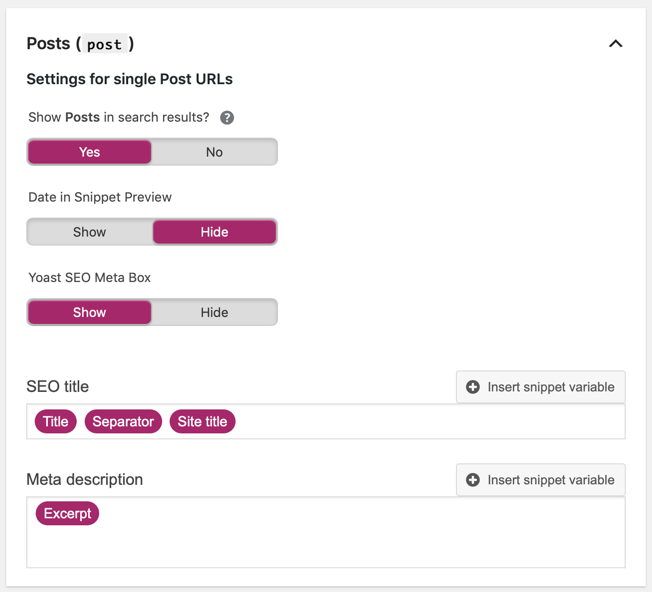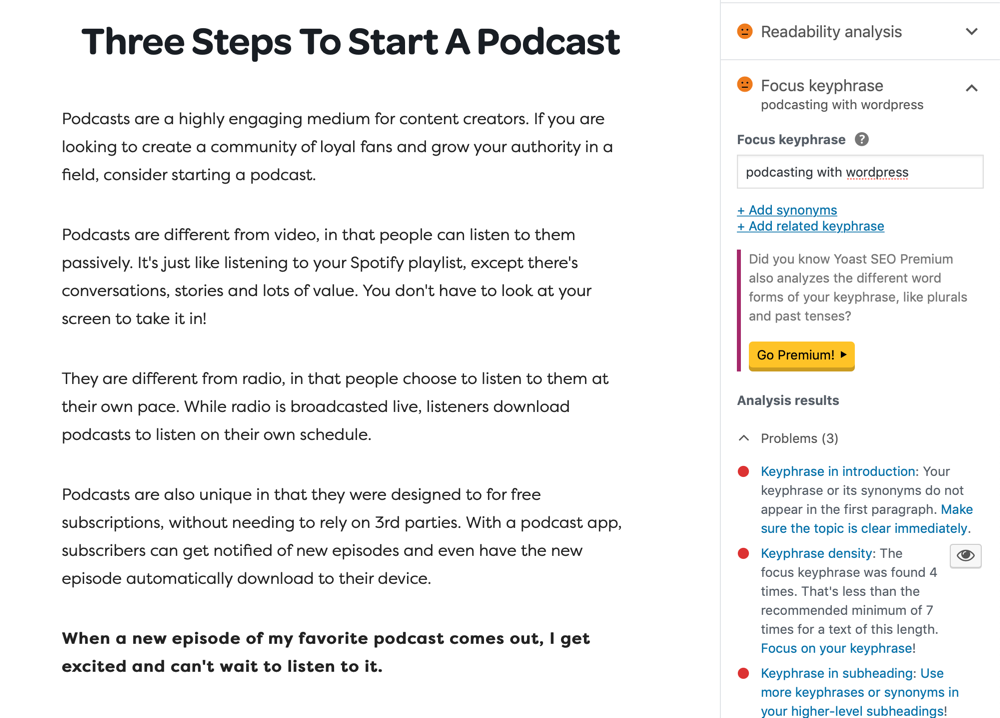If you only have time for one nugget of SEO knowledge, you’ve found it. This article explains the two basic SEO techniques that gives you the biggest bang for your buck.
As we explained previously, the goal is to get visitors to love your website. Do that and Google will love you too, rewarding you with more traffic.
To woo your website visitors, start by making a great first impression. Consider these search results. Which would you rather click on?
Obviously the 2nd result right? Unfortunately a good-looking (optimized) search result doesn’t happen automatically. Therefore our first tip is to learn how to make your search results snippet look good—and more importantly—get search users to click to your website.
Page Titles and Descriptions
A single item shown on the search results page is called a snippet. It consists of a SEO title (in blue), the URL (in green), and the meta description (in black).
To ensure you have the best looking snippet possible on the results page, you’ll want to be able to control the text for the SEO title and meta description. We can do this by using one of the many SEO plugins available for WordPress. We are using the Yoast SEO plugin as an example in this guide, but the same principles apply to any other SEO plugin.
SEO Top Tip #1
Attractive Search Snippets Make Great First Impressions
Optimizing Search Snippets for Posts and Pages
The goal of this step is to make your search snippet attractive so that search engine users want to click on it.
Your SEO plugin will typically add some fields to the post editor for controlling the SEO title and descriptions. Here’s how it looks with the Yoast SEO plugin.

Click the Edit snippet button and you’ll be able to set a title and description for the post or page that you’re editing. A live preview shows you how your snippet will look in the search results and a progress bar indicates the optimal length for your title and description.
Important! Make sure your snippet reflects the content of your page. Your website visitors aren’t going to be happy if their first impressions turned out to be false advertising instead. That’s why it’s important to make sure your custom title and description reflect what is on the page.
With this in mind, if you set your page title to The best Pepperoni Pizza in Miami, your page should be about pepperoni pizza and your subject should be located in Miami. Google is very good at detecting inaccurate—and even deceptive—SEO, and may penalize your website for it.
Subsequently, the next question is: What should your search snippet say? Figuring out the keywords or keyphrases your audience uses will help you decide. We explain further in the next article: How to use keywords in your content. In the meantime, ensure that the search snippet summarizes the content of your page in an interesting way.
Attractive Results Rank Higher
Optimizing your search results snippet doesn’t just make it look good – it will also help you rank higher. Search engines often use the click through rate to determine a website’s ranking. Brian Dean from Backlinko explains how to take advantage of this in his video below.
Set a SEO Title Template
Do I need to optimize each of my blog posts and pages?
If they are important pieces of content (a.k.a. cornerstone content) to growing your audience, I recommend that you do.
For the other content on that you don’t need or want to optimize manually, you can fall back to a default template for SEO title and description. To do that with the Yoast SEO plugin, navigate to SEO → Search Appearance → Content Types. For each content type, you can create a template by filling in the fields with the available snippet variables.

We recommend the template above. This will give you titles like this:

Tip: You can change the separator from the General tab.
Optimize Your Content
By optimizing our page titles and description, we’ve put our best foot forward in the search results. But what happens after the user clicks through to your website?
We want to ensure that we’re impressing them with our content too. So our goal here is two-fold:
- Create clear, understandable content that meets the searchers’ needs
- Ensure our focus keyphrase is used in high-value locations throughout the content to rank higher for that keyword
But how will we know that we’ve met these goals? That’s where your SEO plugin’s content analysis feature will help.
SEO Top Tip #2
Quality Content Impresses Website Visitors AND Search Engines
Content Analysis with Yoast SEO
Most SEO plugins now offer content analysis to grade your content for SEO. As with before, we’ll continue using the Yoast SEO plugin in our examples.

Here is a post before optimization. The Yoast SEO sidebar has been activated, and we’ve filled in “podcasting with wordpress” the focus keyphrase. Yoast analyzes the text content of the post and has given it an orange ? rating for both Readability analysis and Focus keyphrase. You can expand each section to see the Analysis results and recommendations.
The plugin not only tells you what the problems are, but how to resolve it and recommendations. If you click on the blue text in the problem description, you’re presented with even more info on how to fix it.
After addressing the problems, the plugin updates its analysis in real time and updated it’s rating to green ? – yay! As a result, we can be confident that this piece of content has a good chance of earning the affections of website visitors.
Here’s that article from the example above – Beginners Guide to Podcasting With WordPress. Can you see how it’s been optimized for the keyphrase?
However, getting a green happy face isn’t enough to create content that visitors (and Google) will love. Your content needs to have substance – facts, details, and explained in an engaging manner. If your content sucks in the first place, optimizing it won’t make it much better. You also don’t have to address every problem identified in the analysis to get a green happy face. Optimize your content enough and move on.
If you want to learn more about how to use this excellent tool from Yoast, read their blog post: How to use Yoast SEO’s content analysis tool.
While the free version of Yoast SEO is awesome, if you’re serious about SEO do consider purchasing the premium upgrade.
Do you find it hard to create high-quality content? If you do, follow the steps in Fizzle’s free 80/20 Copywriting Workbook. We can’t recommend it highly enough.
Other WordPress SEO Plugins
While we are big fans of Yoast SEO, it is by no means the only SEO plugin available for WordPress. Here are some alternatives for you to consider.
- SEOPress is an all-in-one plugin that also includes Google Analytics integration.
- The SEO Framework bills itself as a smart plugin that uses AI to enable optimal settings for your site.
- Rank Math is a lightweight and modular plugin that claims to help SEO tasks.
- All in One SEO Pack is the original Yoast SEO alternative with many fans of its slim and utilitarian interface.
As you can see, there are many options for you to choose from. Pick one, learn its features and stick with it. Above all, remember that…
SEO Is More Than A Plugin
It’s tempting to leave all the SEO tasks to a plugin. But as I have shown, the essential SEO tasks aren’t all that difficult:
- Optimize your search titles and descriptions
- Produce readable content with your focus keyphrase
These are tasks that can’t be automatically done by a plugin, regardless how smart it is. You must still take the time to do these steps yourself. With some consistent effort, visitors will fall in love with your website and Google will reward you with a flood of SEO traffic.

